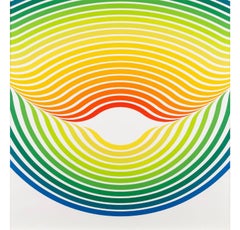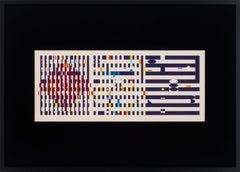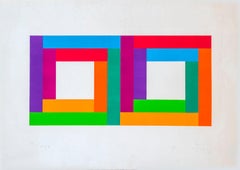Herbert Oehm Art
to
2
Overall Width
to
Overall Height
to
2
2
2
2
9,478
2,687
1,375
1,358
2
2
Artist: Herbert Oehm
Swing III (Big Drop) by Herbert Oehm, 1972
By Herbert Oehm
Located in Kingsclere, GB
Swing III (Big Drop) by Herbert Oehm, 1972
Additional information:
Medium: screenprint
72 x 72 cm
28 3/8 x 28 3/8 in
signed and numbered in pencil
Herbert Oehm is a German Postwar ...
Category
20th Century Herbert Oehm Art
Materials
Screen
Swing IV by Herbert Oehm, 1972
By Herbert Oehm
Located in Kingsclere, GB
Swing IV by Herbert Oehm, 1972
Additional information:
Medium: screenprint
72 x 72 cm
28 3/8 x 28 3/8 in
signed and numbered 66/175 in pencil
Herbert Oehm is a German Postwar & Con...
Category
20th Century Herbert Oehm Art
Materials
Screen
Related Items
“Three Movements" Limited Edition Hand-Signed Serigraph by Yaacov Agam, Framed
By Yaacov Agam
Located in Encino, CA
"Three Movements," an original silkscreen by Yaacov Agam, is a piece for the true collector. Agam is considered the father of Kinetic art. His iconic style is recognizable across the...
Category
1970s Kinetic Herbert Oehm Art
Materials
Screen
$5,000
H 30.125 in W 41.875 in D 1.25 in
Untitled, from ‘The International Association of Art Portfolio’
By Max Bill
Located in Llanbrynmair, GB
Untitled, from ‘The International Association of Art Portfolio’
By Max Bill
Medium - Screen print
Edition - 3/25
Signed - Yes
Size - 640mm x 460mm
Date...
Category
Mid-20th Century Abstract Herbert Oehm Art
Materials
Screen
$1,772
H 18.12 in W 25.2 in
Pleased to Meet You Again
Located in North Adams, MA
Silkscreen in 9 colors on 320 gram Coventry Rag
Dimensions: 29" x 29"
Signed by the Artists in pencil
An edition of 75
John “CRASH” Matos and Eric Orr met for the first time as high school students. Although the exact location is unclear, both agree that it would have been at either Fashion Moda or the Writers’ Bench at 149th Street and Grand Concourse.
Founded by Stefan Eins in 1978, Fashion Moda began as a “cultural concept” whose principles revolved around the fact that art can be made by anyone, anywhere and art should be accessible to anyone, anywhere. Located in the South Bronx, Fashion Moda embraced new talent and encouraged creative production across all mediums. The gallery has been credited as a major force behind the recognition of graffiti writing as an art form and it played a pivotal role in a community where Hip Hop was rapidly emerging. CRASH was only 19 years old when he curated “Graffiti Art Success for America” at Fashion Moda and his varied experiences at the gallery would later inspire his founding of WALLWORKS.
The 149th Street Writers’ Bench, located at the back of the uptown...
Category
21st Century and Contemporary Street Art Herbert Oehm Art
Materials
Screen
untitled
Located in New York, NY
Untitled screenprint published in 1972 in an edition of 42. This is example number 4.
Category
1970s Abstract Herbert Oehm Art
Materials
Screen
Lincoln Center's Mostly Mozart Festival - 25th Anniversary
By Robert Motherwell
Located in Aramits, Nouvelle-Aquitaine
Robert Motherwell, American (1915 - 1991)
Lincoln Center's Mostly Mozart Festival, 25th Anniversary.
Lithograph, Edition of 800, unsigned and unnumber...
Category
1990s Abstract Expressionist Herbert Oehm Art
Materials
Lithograph, Screen
$2,063
H 42.38 in W 31.63 in D 0.6 in
untitled
Located in New York, NY
Gestural screenprint, number 12 from an edition of 20
Category
1970s Abstract Herbert Oehm Art
Materials
Screen
Serie Madrid B, 1990
By Jesús Rafael Soto
Located in Miami, FL
Jesus Soto (1923-2005)
Serie Madrid B, 1990
Denise Rene Editeur, Paris (with Denise Rene's blind-stamp)
Screen print in heavy paper
59 x 45.3 in (150 x 115 cm)
Professionally framed...
Category
1960s Abstract Geometric Herbert Oehm Art
Materials
Screen
untitled (orange)
By Richard Hunt
Located in New York, NY
Untitled (orange) 1980 screenprint by Richard Hunt measuring 22 by 30 inches. This example is designated 41 from an edition of 80. The work is professionally matted.
Category
1980s Abstract Herbert Oehm Art
Materials
Screen
untitled
Located in New York, NY
gestural screenprint, number 5 from an edition of 40
Category
1970s Abstract Herbert Oehm Art
Materials
Screen
"Loveletter I" Screen Print, Limited Edition
By Cryptik
Located in Palm Desert, CA
„Loveletter I“ by Cryptik
Serigraph Print on 280gsm Sirio Ultrablack Paper
Size 71 × 71 cm
Signed and numbered (42/99), in pencil along lower edge
Cryptik is a Los Angeles based artist who creates from a palette of wonder, where all science, math, and true art spring from equal mystery. His is a clear-eyed art...
Category
2010s Street Art Herbert Oehm Art
Materials
Screen
Formulation : Articulation. Folio of 2 prints
By Josef Albers
Located in Llanbrynmair, GB
’Formulation : Articulation’
By Josef Albers
Medium - Serigraph on Mohawk Superfine Bristol paper. In Folio of 2 prints
Signed - No
Edition - 1000, Portfolio II, Folder 20
Size ...
Category
1970s Abstract Herbert Oehm Art
Materials
Screen
Raised Eyebrows / Furrowed Foreheads: Crooked Made Straight
By John Baldessari
Located in New York, NY
9-color silkscreen print on plexiglass,
5 x 12” (12,5 x 31cm)
Printed by Atelier für Siebdruck,
Lorenz Boegli, Zurich
Ed. 45/XX, signed and numbered certificate
Category
Early 2000s Herbert Oehm Art
Materials
Screen
$2,500
H 5 in W 12 in D 0.25 in
Herbert Oehm art for sale on 1stDibs.
Find a wide variety of authentic Herbert Oehm art available for sale on 1stDibs. If you’re browsing the collection of art to introduce a pop of color in a neutral corner of your living room or bedroom, you can find work that includes elements of yellow and other colors. You can also browse by medium to find art by Herbert Oehm in screen print and more. Not every interior allows for large Herbert Oehm art, so small editions measuring 29 inches across are available. Herbert Oehm art prices can differ depending upon medium, time period and other attributes. On 1stDibs, the price for these items starts at $2,861 and tops out at $2,861, while the average work can sell for $2,861.



